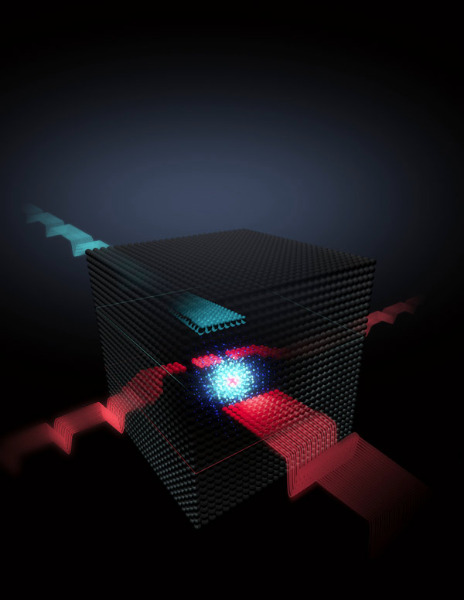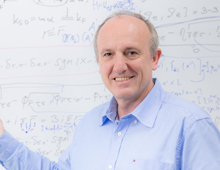
Our team works on the quantum theory of condensed matter with a focus on spin and topological phenomena in semiconducting and magnetic nanostructures. In particular, we investigate novel mechanisms and seek new platforms hosting topological or spin phases in solid-state systems, including helical spin texture, topological insulators and topological superconductors, which have potential hosting topological quantum states, such as Majorana fermions and parafermions. Moreover, we also investigate (quasi-)one-dimensional Tomonaga-Luttinger liquid, nuclear spins in semiconductors, many-body effects in low-dimensional systems, (fractional) quantum Hall effect, strongly correlated electron systems, spin-orbit interaction, and quantum transport phenomena.
Helical Liquids in Semiconductors
One-dimensional helical liquids can appear at boundaries of certain condensed matter systems. Two prime examples are the edge of a quantum spin Hall insulator, also known as a two-dimensional topological insulator, and the hinge of a three-dimensional second-order topological insulator. The presence of such states serves as a signature of their nontrivial bulk topology.
We investigate various aspects of helical liquids, such as their realization, topological protection and stability, or possible experimental characterization. We focus especially on proximity-induced topological superconductivity, allowing for exciting applications towards topological quantum computation with the resulting Majorana bound states.

Helicity. (Left) In particle physics, the helicity of a particle is defined through the relative orientation between its spin and momentum. (Right) In a condensed matter system hosting spin-1/2 fermions with quadratic dispersion, we can label the degenerate states near the Fermi level either by their spins or by their helicities. Unlike the spin, the states with opposite helicities can be split in a time-reversal-invariant system.
Chen-Hsuan Hsu, Peter Stano, Jelena Klinovaja, and Daniel Loss, “Helical Liquids in Semiconductors”, Semicond. Sci. Technol. 36, 123003 (2021).© IOP Publishing
Majorana Kramers pairs in higher-order topological insulators
Higher order topological insulators are systems which realize the most recent flavor of topological matter. While being insulating in the bulk and on the surface, they host propagating states at the edges (hinges), where two facets meet. We designed a tune-free scheme to realize Kramers pairs of Majorana bound states in higher-order topological insulators with proximity-induced superconductivity.
Our scheme is an experimentally accessible setup, which proposes to use a bismuth wire half-covered by a superconductor. Namely, we find that when two hinges with the same helicity of the wire are in contact to an s-wave superconductor, moderate electron-electron interactions favor the inter-hinge pairing over the intra-hinge pairing, leading to formation of Majorana Kramers pairs. As a result, the proposed scheme does not require a magnetic field or local voltage gates, which is a highly desired property in the quest for topological states.

Left panel: Higher order topological insulator realized using a superconductor (yellow) and a wire (green). Right panel: The phase diagram of the model shown in the Left panel.
Chen-Hsuan Hsu, Peter Stano, Jelena Klinovaja, and Daniel Loss, “Majorana Kramers Pairs in Higher-Order Topological Insulators,” Phys. Rev. Lett. 121, 196801 (2018) © APS
<!–
Topological Floquet Phases in Driven Coupled Rashba Nanowires
Even though the most of the recent studies of topological matter were focused on static structures, it has been recently proposed to extend the investigations to non-equilibrium systems. We circumvent the difficulty of analysis of a two-dimensional system with electron-electron interactions by considering a strongly anisotropic 2D system formed by weakly coupled Rashba wires (see the figure), where each of them can be treated as a one-dimensional Luttinger liquid by bosonization. This allowed us to introduce the Floquet version not only of topological insulators but also of Weyl semimetals in driven 2D systems. Importantly, in this way we can also address fractional regimes and are able to obtain the Floquet version of fractional TIs and Weyl semimetals.

Upper panel: An array of quantum wires under a time dependent driving realizing the Floquet topological insulator.
Lower panel: The phase diagram of the model shown in the upper panel as a function of the Floquet coupling tF and the tunneling amplitude t2.
J. Klinovaja, P. Stano, D. Loss, “Topological Floquet Phases in Driven Coupled Rashba Nanowires”, Phys. Rev. Lett. 116, 176401 (2016) © APS
–>






